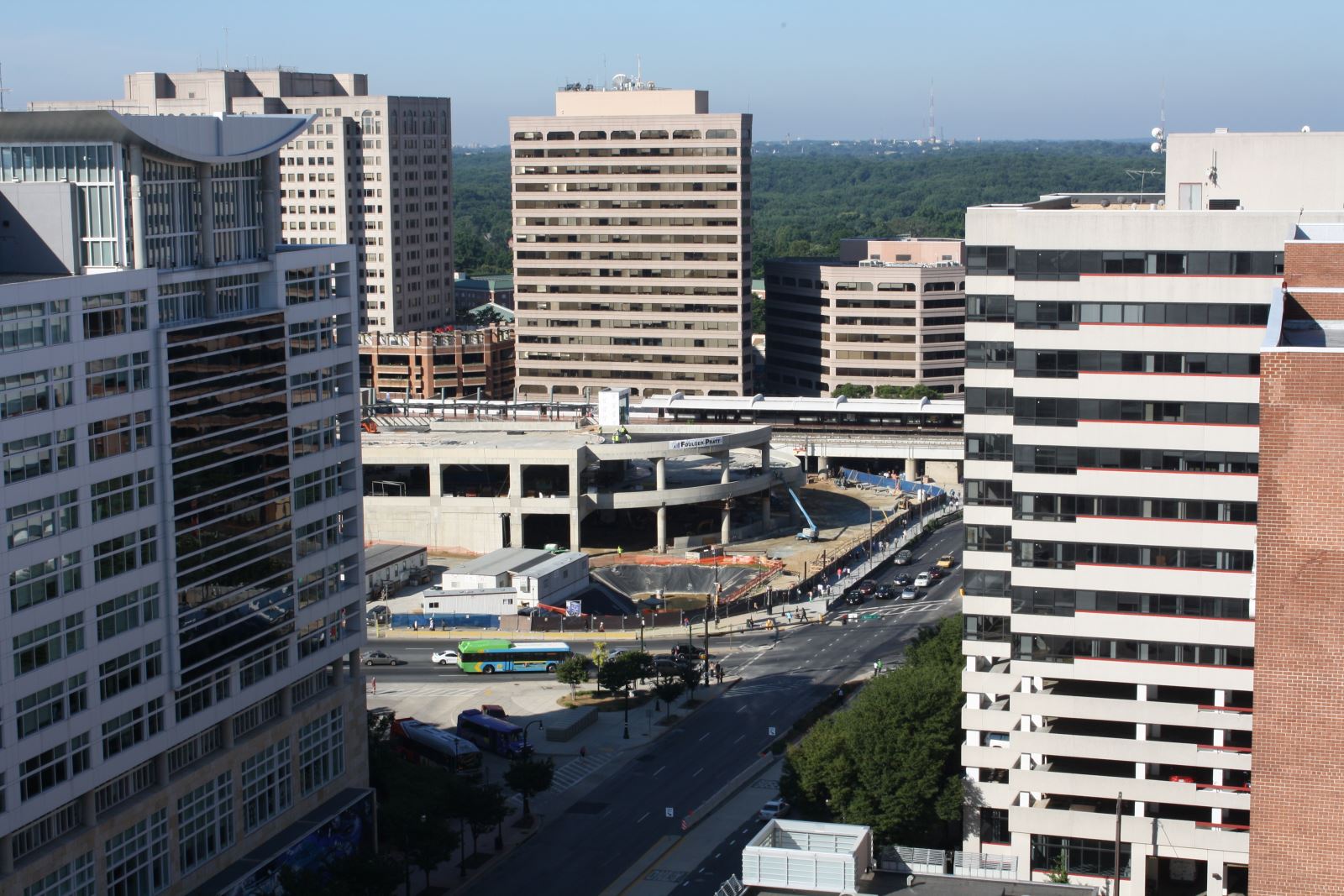Photo above: Silver Spring Transit Center and Metro station, center, from a distance. (Photo by Bruce Lee)
By Charlie Hayward
Serious safety, soundness, and durability problems that are now causing indefinite delays with opening the $112 million Silver Spring Transit Center (SSTC) were attributable to negligence, inadequate oversight and other shortcomings with project management, construction, and engineering.
In other words, none of the principal parties has “clean hands” according to a study released last week by the independent Office of Inspector General (IG) for Montgomery County.
Inadequate project management and control
The superstructure is made of concrete and thus construction specifications were replete with engineering criteria for the composition of the concrete, and its pouring, curing and tensioning. The IG systematically examined 22 project management and control points from the time concrete was mixed until the time it was ready for final inspection. The IG team obtained assistance from Alpha Corporation, an engineering expert.
The IG’s analysis found that 14 of 22 control points that should have minimized defects were weak or ineffective, leading to significant problems and latent defects.Those defects may require recurring engineering inspections, higher maintenance costs, and they could shorten the planned 50-year useful life. In addition, the IG described the risk of concrete falling onto transit-center patrone.
The study also found fault with the county assigning the construction contractor, Foulger-Pratt Contracting LLC, as both the builder and the construction manager. The study said that an independent third-party construction manager should have provided a “peer review” function.
Facility defects
The IG found that the composition of the concrete, and its curing and tensioning didn’t meet contract requirements, causing reduced structural strength. It was not detected by Robert B. Balter Company, the contractor responsible for resident inspection.
- Too much water added to concrete, which ultimately reduced its strength. Routine tests of the concrete should have identified the problem, but test samples were taken before the water was added, making test results incompatible with the concrete on site.
- Cold-weather curing was not done per contract specs and surface temperatures were not maintained or monitored as required. This could have contributed to the early shrinkage observed in the concrete.
- All contractors (design, construction, and inspection) became aware that concrete wasn’t uniformly thick in time to correct the deficiencies, but never fixed the problems.
- Defects involving pour strips, the sections of concrete laid in place to control shrinkage and assure proper uniformity of concrete thickness, were due to poor communication and professional error, the study found.
The IG also reported that there were concerns about design deficiencies that were not addressed, even as contractors reported continued, unexpected concrete cracking and elevated those concerns quickly to the county’s design engineer, Parsons Brinckerhoff, Inc. Also, the IG reported that construction specifications didn’t contain a clear protocol for problem resolution, which could have included reducing payments to contractors until problems are resolved.
Project had a troubled past
The concrete problems aren’t the first piece of bad news in a project that has exponentially grown in scope and funding and is taking much longer to build than originally anticipated. When County Executive Doug Duncan held a press conference to discuss it in 1997, he said it would be done by 1998.
After an early design concept was released in 1998, the project began to grow, fueled by concerns that it be aesthetically compatible with Silver Spring’s redevelopment efforts. What was once a state-funded $20 million project became a $73 million project mostly financed by federal grants, and then the cost jumped again by the time a groundbreaking ceremony was held Sept. 28, 2008. The costs at that time were estimated at $93 million, with nearly $54 million in federal funding and an early-2011 completion.
After digging started, problems were discovered with underground utilities and environmental contamination.
A grass-roots organization, Action Committee for Transit, has awebsite that tracks the SSTC’s history of scope increases, challenges, cost overruns and delays since October 1993.The county also has an informativewebsite.
No clear path to resolution
The parties (County, WMATA, and contractors) seem to be cooperating towards putting the transit center in operation as soon as possible, and resolving their differences. The pathway to opening the SSTC, however, depends on WMATA and the County negotiating terms over extraordinary long-term costs that WMATA claims will be caused by structural defects. In addition, Foulger-Pratt’s final price tag will not be known for some time because of unresolved high-dollar contractual disputes.
Barriers to Opening the Facility
Remediation work began in September 2013 and continues. The County believes Foulger-Pratt’s remediation work will eliminate the need for any future repairs due to defects. That view is not shared by WMATA, which says it will require indemnification by the County and a long-term maintenance fund to pay for any problems WMATA experiences outside normal operation and maintenance.
Final Price Tag Unknown
Foulger-Pratt maintains the structure it built complies with its contract. Moreover, it has notified the County of several claims for work, for which payment terms have yet to be negotiated. One of those claims says the County delayed or disrupted Foulger-Pratt’s work, alleging that $7,525/day of delay costs would begin to accrue in Feb. 2013. There is no compilation of the total, although it appears comfortably above $10 million. The County will attempt to resolve these claims without litigation. However, failures of the closeout negotiations could lead to protracted delays and a much higher final price tag.






Recent Comments